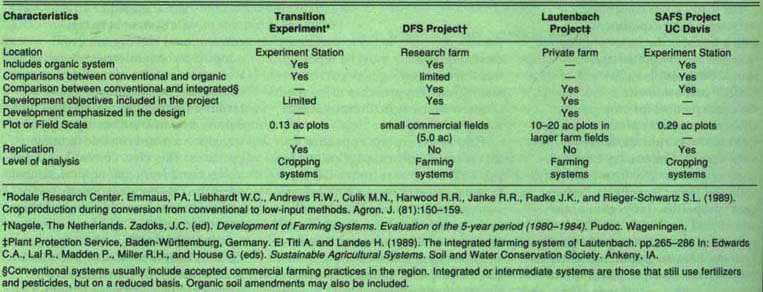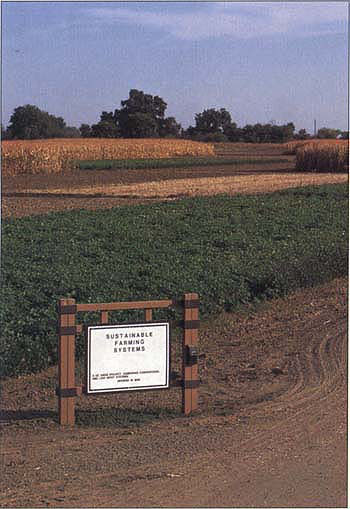All Issues
Farming in transition: Analysis – Scientists and farmers try new approach to research
Publication Information
California Agriculture 48(5):11-13.
Published September 01, 1994
PDF | Citation | Permissions
Abstract
The Sustainable Agriculture Farming Systems Project is one of several newer, large-scale experiments that have contrasted idealized cropping practices with existing ones. The common objective of these experiments has been to develop and compare cropping systems substantially different from current practice, with each system following separate rules of management. Difficult conceptual and methodological issues arise when both development and research are objectives in a project, and when many factors change simultaneously.
Full text
For many years controlled, short-term field experiments with a few specific factors of interest have advanced applied agricultural research. Such studies allow scientists to identify cause and effect and predict the consequences for crop growth when management practices change. Field plot experiments, however, have some notable limitations. Certain types of phenomena are missed: large-scale and long-term effects, “emergent” properties (properties of the whole) and the sociological and environmental characteristics of farming systems. Because additional factors are now of interest, especially those having to do with agriculture's effects on the environment, many experiments carried out before must be repeated, this time measuring new parameters, and different approaches using methods new to the agricultural sciences may prove helpful.
The next four articles describe early results from a UC Davis project comparing conventional, low-input, and organic farming systems (pp. 14–42). These systems were managed by a team of UC Davis researchers and area growers, who attempted in all cases to apply “best farmer practice.” However, because the systems were inherently different they were managed differently. For instance, crop rotations were altered in some systems but not others. The results had immediate utility for growers but presented challenges for scientific interpretation.
To provide background on the systems approach to research, we present the following analysis by Stephen Kaffka, a UC Davis agronomist who recently has taught a graduate course on farming systems research.
The project itself — UC Davis' Sustainable Agriculture Farming Systems (SAFS) project — consists of a 20-acre main experiment planted with processing tomatoes, safflower, corn and wheat followed by double-cropped dry beans. —Ed.
Four of the reports appearing in this issue of California Agriculture ( see pp. 4–42 ) are drawn from a UC Davis farming systems research and development project carried out by a diverse group of faculty, together with farmers and farm advisors. The Sustainable Agriculture Farming Systems (SAFS) project was funded partially by the statewide Sustainable Agriculture Research and Education Program and is part of a recent trend toward the analysis of complexity and the use of novel approaches in research. Two important issues are raised by these reports. One is the idea that agriculture might need to change in some fundamental way. Another is the value and practicality of comparing complex sets of cropping practices.
Agricultural practice changes constantly and all research is about change, including traditional types of research. The focus of the SAFS project implies that a substantially different way of farming may be needed and should be investigated. For comparison, the participants have created an organic farming system, a low-input system (defined as an intermediate system between conventional and organic), and adopted a conventional system with two variations, 2-year and 4-year crop rotations. The inclusion of organic farming techniques implies that “agriculture in transition” could mean a transition toward organic farming practices. This view continues to provoke controversy among professional agriculturists because organic methods rule out the use of many practices of proven utility.
While the SAFS project is unique in California, it is consistent in outlook and, partially, in approach with a number of projects elsewhere investigating alternative methods of farming. What follows is a comparison of the SAFS project with projects having common objectives, and comments on the conceptual and methodological issues raised by the use of novel methods.
Conceptual issues
Systems science is an independent discipline, originating in a formal manner largely since the Second World War. While the term “system” is widely used, there are a range of meanings associated with it and many different types of research deserve to be considered systems research. A systems approach can apply to crop and livestock production at several levels of organization, as outlined in the accompanying text box. Issues including labor, pesticide and energy use, nutrient cycling, drainage and the efficiency of sunlight capture can be examined at each of these levels. Agricultural systems research was initially associated with the use of various computer modeling techniques. More recently, agricultural research with an on-farm component also has been called systems research by some scientists. Other definitions of systems research emphasize the social (interactive) and iterative aspects of the decision-making process. Another systems approach involves the use of multiple factor experiments comparing complex combinations of farming practices. The SAFS project belongs to this type of systems research.
Terms defined
Cropping system:: A crop or pasture community, together with management practices such as tillage methods and rotations.
Farming system:: The principal crops and management practices employed on a farm.
Agricultural system:: The regional organization of farming systems.
: Source: Loomis R.S. and Connor D.J. (1992). Crop Ecology, Cambridge University Press. NY. p. 538.
The adoption of a systems approach can be a mixed blessing. By choosing to work with combinations of farming practices, researchers are confronted with several challenges. One is the number of factors to be analyzed. The larger and more complex the system, the more difficult it is to comprehend conceptually, let alone quantitatively. Clear definition is another: what exactly is being studied? Rather than simply accepting the use of the term “system,” it is useful to ponder what is intended and what is implied by its use. For example, one intuitive definition would be that “system” refers to a set of strongly connected phenomena which must be viewed together for their integrative properties to emerge. If phenomena are strongly connected, then it should not be possible to change any part and still analyze the same system. If a group of farming practices form a system in this sense, it may not be useful to study those practices by varying them one factor at a time — the distinguishing characteristic of most agricultural experiments.
Issues of method
Just as simple factorial experiments have limitations, so do multiple factor experiments. When many factors change simultaneously the unambiguous comparison and interpretation of treatment differences becomes difficult. Cause and effect are hard to determine and frequently can only be identified in adjoining, simpler experiments. A different problem is generalization, which is always an issue in agricultural research, but especially troublesome with complex experiments. Can results from multiple factor experiments be extrapolated to other combinations of practices that are analogous but not exactly the same, or to other locations? What are the methods and limits of extrapolation? If results cannot be widely extrapolated, then what are the benefits from the process?
Different research groups address these questions in varying ways. Each solution is unique. A few of the relevant projects of this type are compared with the SAFS project in table 1. All the projects sought to develop idealized sets of cropping practices and compare them with existing ones. The two European projects included development (change) as a characteristic. That decision, combined with a lack of replication, limited the kinds of analyses that could be carried out among the systems compared. For the Development of Farming Systems (DFS) project, conventional, integrated and organic systems were compared. Measurements of as many factors as feasible were made. Items analyzed included yields of common crops, nitrate loss and kilograms of active ingredients of pesticides used. Yearly differences between the contrasting systems for the factors of interest were compared over time for trends (the slope of the regression of differences between systems versus time was analyzed to see if it was significantly different from zero). Analysis of variance was not possible because treatments were not replicated. The Lautenbach Project in Germany compared only conventional and integrated systems, and likewise was limited to largely descriptive measurements and the use of pseudo-replication (multiple samples drawn from the same experimental unit, such as a plot or field). Each system's overall economic return and amount of pesticides used were considered the most important criteria for comparison. Importantly, the Lautenbach Project was very successful as an extension effort, one of its primary goals. Local farmers solved the problem of generalization by adopting those practices from the project that made sense to them. This kind of success shows that applied projects may have an influence on farming without being definitive scientifically.
The Rodale organization's project (Transition Experiment in table 1) followed formal principles of experimental design, allowing for hypothesis testing and direct comparison of means. Like the European projects, researchers compared complex combinations of practices, in this case focusing on differences between conventional and organic systems. To preserve consistency, changes in treatments within the first cropping cycle were not allowed, meaning that flawed practices could not be corrected immediately. This reduced the practical value of comparisons that did not reflect the responses farmers would make, but preserved experimental rigor.
Like the Rodale project, the SAFS project has followed principles of experimental design, but instead has accommodated changes within the first crop rotation cycle. Something as complex as a cropping system cannot be invented all at once in final, successful form. The decision to investigate a new way of farming means that the need to alter some practices will arise. Changing treatments compromises an experiment, but not changing them reduces its realism and immediate relevance to current farming practice. The management problem is circular. Improvements have been made to all the systems studied in the SAFS project, not just to the organic one. The interactive management of the project by researchers, farm advisors and growers ( see p. 14–19 .) has resulted in the evenhanded treatment of all the systems compared, an evenhandedness rare in the literature. This increases the value of the comparisons for certain purposes, particularly demonstration. In time, refined cropping systems may yield useful insights.
Agricultural science includes many disciplines because no single viewpoint or approach can encompass all the complexity involved. The research reports that follow reflect a change in perspective on what is needed for agriculture to thrive. A project cannot be regarded as suspect because organic farming comparisons are included, or non-traditional methods are used. On the other hand, a project is not automatically more valuable (or valid) because alternative practices are investigated using unusual methods. We do not want to miss new insights by clinging rigidly to experimental orthodoxy. At the same time, the need for improvement is not well served by ambiguous results. When nontraditional projects come along, the challenge for the journal's readers increases. Additional critical judgment should be applied.






